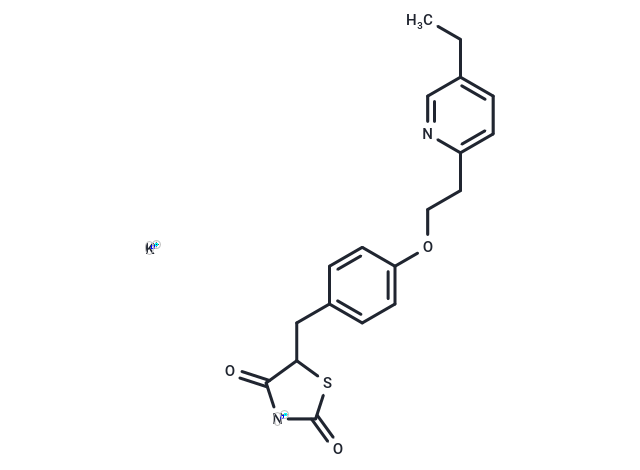Shopping Cart
Remove All Your shopping cart is currently empty
Your shopping cart is currently empty
Pioglitazone potassium (U 72107) is an orally active, selective agonist of peroxisome proliferator-activated receptor gamma (PPARγ), exhibiting high-affinity binding to the ligand-binding domain of PPARγ with EC50 values of 0.93 μM for human and 0.99 μM for mouse PPARγ. It has applications in diabetes research [2] [3] [4].

| Pack Size | Price | USA Warehouse | Global Warehouse | Quantity |
|---|---|---|---|---|
| 1 mg | $105 | 35 days | 35 days | |
| 5 mg | $198 | 35 days | 35 days | |
| 10 mg | $362 | 35 days | 35 days | |
| 50 mg | $1,390 | 35 days | 35 days |
| Description | Pioglitazone potassium (U 72107) is an orally active, selective agonist of peroxisome proliferator-activated receptor gamma (PPARγ), exhibiting high-affinity binding to the ligand-binding domain of PPARγ with EC50 values of 0.93 μM for human and 0.99 μM for mouse PPARγ. It has applications in diabetes research [2] [3] [4]. |
| Targets&IC50 | PPARγ (human):0.93 μM (EC50), PPARγ (mouse):0.99 μM (EC50), PPARα (mouse):100 μM (EC50), PPARδ (human):43 μM (EC50), PPARα (human):100 μM (EC50) |
| In vitro | Pioglitazone potassium, at concentrations of 0.5 or 1 μM over 5 days, can effectively counteract the necrosis of β-cells and the elevation of caspase-3 activity induced by advanced glycation end-products (AGEs), thus preserving the viability of the pancreatic beta cell line HIT-T15 [2]. Additionally, a 1-hour exposure to 1 μM pioglitazone potassium enhances insulin secretion in response to low glucose levels and moderates the GSSG/GSH ratio in cells exposed to AGEs [2]. |
| In vivo | Administered orally via gavage at doses of 10 or 30 mg/kg once daily for 14 days, Pioglitazone potassium has been shown to ameliorate insulin resistance and diabetes, potentially through mechanisms involving lipocalin in the liver, though not in skeletal muscle [3]. Furthermore, a dosage of 10 mg/kg administered daily for four weeks has notably reduced body weight, cardiac hypertrophy, high blood glucose levels, and improved dyslipidemia [4]. In ob/ob and adipo -/- ob/ob mice on a C57Bl/6 background, a dosage of 10 mg/kg did not alter serum free fatty acid and triglyceride levels nor adipocyte sizes, but a increased dosage to 30 mg/kg resulted in significant reductions. Likewise, no change was observed in the expression of TNFα and resistin in adipose tissues at 10 mg/kg, while a decrease was noted at 30 mg/kg. In male Wistar albino rats, a four-week treatment at 10 mg/kg led to decreased serum levels of creatinine and creatine kinase-MB (CK-MB), down-regulation of TGF-β1 gene expression, and adjustment in the expression of the MMP-2/TIMP-2 system. |
| Molecular Weight | 394.53 |
| Formula | C19H19KN2O3S |
| Cas No. | 1266523-09-4 |
| Smiles | [K+].CCc1ccc(CCOc2ccc(CC3SC(=O)[N-]C3=O)cc2)nc1 |
| Storage | Powder: -20°C for 3 years | In solvent: -80°C for 1 year | Shipping with blue ice/Shipping at ambient temperature. |
| Size | Quantity | Unit Price | Amount | Operation |
|---|

Copyright © 2015-2026 TargetMol Chemicals Inc. All Rights Reserved.